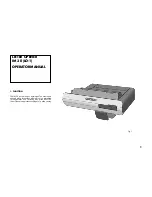
1
2
3
1
2
3
+
—
W
N
P
B
V
V
U
P
W
N
B
U
3
2
1
6
5
4
9
8
7
11
13
10
14
15
12
16
Pre-Driver
Pre-Driver
Pre-Driver
Pre-Driver
Pre-Driver
Pre-Driver
Over heating
Temperature sensor
protection circuit
16 10 7 4 1
Black
(+)
P
N
U
V
W
Red
(–)
P
∞
∞
∞
∞
∞
∞
N
5~200
Ω
5~200
Ω
5~200
Ω
5~200
Ω
5~200
Ω
5~200
Ω
U
V
W
• Judgement value
Black
(+)
+ (P)
- (N)
~ (1)
~ (2)
~ (3)
Red
(–)
+ (P)
∞
∞
∞
∞
∞
∞
- (N)
5~200
Ω
5~200
Ω
5~200
Ω
5~200
Ω
5~200
Ω
5~200
Ω
~ (1)
~ (2)
~ (3)
• Judgement value
• External view
• Internal circuit diagram
(5) Intelligent power module (IPM)
Measure resistances between each terminal of IPM with tester, and use the results for troubleshooting
Notes on measurement
• Make sure the polarity before the measurement. (On the tester, black normally indicates plus.)
• Make sure that the resistance is not open (
∞Ω
) or not shorted (to 0
Ω
).
• For the resistance, the margin of error is allowed.
• The result that is more than double or half than the result that is measured at the same measurement point
is not allowed.
Tester restriction
• Use the tester whose internal electrical power source is 1.5V or greater.
• Use the dry-battery-powered tester.
(
✻
The accurate diode-specific resistance cannot be measured with the button-battery-powered card tester,
as the applied voltage is low.)
• Use the range that measures low resistance as much as possible.
The more accurate resistance can be measured.
(6) Diode stack
Measure resistances between each terminal of diode stack with tester, and use the results for troubleshooting.
Refer to (5) “ Intelligent power module (IPM) ” for notes on measurement and tester restriction.
–
–
–
–
–
–
–
–
–
–
–
–
–
–
–
–
- 146 -
















































